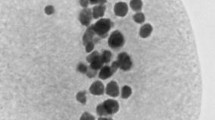Summary
The meiosis of a 36-chromosome plant ofSolanum demissum of undoubted polyhaploid origin is described. The significance of the type of pairing is discussed and the probable genomic constitution ofABB 1 for the polyhaploid andAABB 1B1 forS. demissum is proposed. Cytological studies of hybrids betweenS. demissum and recently described Demissa hexaploids show the first instance of gross meiotic unbalance in species hybrids of tuberousSolanums, and give further indication of genomic differentiation in the group Demissa. From an analysis of this behaviour, supported by the observations on polyhaploidS. demissum, a tentative scheme has been drawn up giving the genomic constitution of the hexaploids. From it their interrelationships are revealed and their possible origin discussed.
Similar content being viewed by others
References
Bains, G. S. &Howard, H. W. (1950). Haploid plants ofSolanum demissum.Nature, Land., 166. 795.
Cooper, J. P. &Howard, H. W. (1952). The chromosome numbers of seedlings from the crossSolnnum demissum × tuberosum backcrossed byS. tuberosum. J. Genet.50, 511–21.
Correll, D. S. (1952). SectionTuberarium of the genusSolanum of North America and Central America.Agric. Monogr. no. 11, pp. 243.
Dodds, K. S. (1950). Polyhaploids ofSolanum demissum.Nature, Lond.,166, 795.
Hawkes, J. G. (1944). Potato collecting expeditions in Mexico and South America. II. Systematie classification of the collection. Tech. Commun. Bur. Pl. Breed. Cambridge. pp. 142.
Hawkbs.J. G. (1954). New Solanum species in sub-sectionHyperbasarthrum Bitt.Ann. Mag. Nat. Hist.7, 689–710.
Hawkes, J. G. (1955). Hybridization studies on four hexaploid.Solanum species in sectionHyperbasarthrum Bitt. (In preparation.)
Howard, H. W. &Swaminathan, M. S. (1952). Speoies differentiation in the sectionTuberarium ofSolanum with particular reference to the use of interspecific hybridization in breeding.Euphytica,1, 20–28.
Howard, H. W. &Swaminathan, M. S. (1953). The cytology of haploid plants ofSolanum demissum.Genetica,26, 381–91.
Jørgensen, C. A. (1928). The experimental formation of heteroploid plants hi the genusSolanum.J. Genet.19, 133–211.
Koopmans, A. (1951). Cytogenetic studies onSolanum tuberosum L. and some of its relatives.Genetica,25, 193–337.
Lamm, R. (1945). Cytogenetic studies inSolanum sect.Tuberarium. Hereditas, Lund,31, 1–128.
Lamm, R. (1953). Investigations on some tuber bearingSolanum hybrids.Hereditas, Lund,39, 97–112.
Marks, G. E. (1952). A controllable carmine technic for plants with small chromosomes.Stain Tech.27, 333–36.
Marks, G. E. (1954). An aceto-carmine glycerol jelly for use in pollen-fertility counts.Slain Tech. (in the Press).
MÜntzing, A. (1933). Studies on meiosis in diploid and triploidSolarium tuberosum.Hereditas, Lund,17, 233–45.
Olah, L. V. (1938). Cytogenetische Unterzuehungen in der GattungSolanum Sect.Tuberarium. III.S. commersonii Dunn, und einiger seiner Bastarde.Z. indulct. Abstamm.— u. VererbLehre,74, 228–41.
Prakken, R. &MÜntzing, A. (1942). A meiotic peculiarity in rye, simulating a terminal centromere.Hereditas, Lund,28, 441–82.
Propach, H. (1937). Cytogenetische Untersuchungen in der GattungSolanum Sect.Tuberarium. II. Triploid und tetraploide Art-bastarde.Z. indukt. Abstamm.- u. VererbLehre,73, 143–54.
Stebbins, G. L. (1945). The cytological analysis of species hybrids. II.Bot. Rev.11, 463–86.
Stephens, S. G. (1950). The internal mechanism of speciation inGossypium.Bot. Rev.16, 115–49.
Prakken, R. &Swaminathan, M. S. (1952). Cytological behaviour of some interspecific hybrids in the genusSolanum., sectTuberarium. Genetica,26, 77–191.
Swaminathan, M. S. &Howard, H. W. (1953). The cytology and genetics of the potato (Solanum tuberosum) and related species.Bibliogr. genet.16, pp. 192.
Thomas, P. T. (1945-6).36th Annual Report of the John Innes Horticultural Institution, pp. 11.
Author information
Authors and Affiliations
Rights and permissions
About this article
Cite this article
Marks, G.E. Cytogenetic studies in tuberousSolanum species I. Genomic differentiation in the group demissa. J Genet 53, 262–269 (1955). https://doi.org/10.1007/BF02993980
Received:
Issue Date:
DOI: https://doi.org/10.1007/BF02993980



